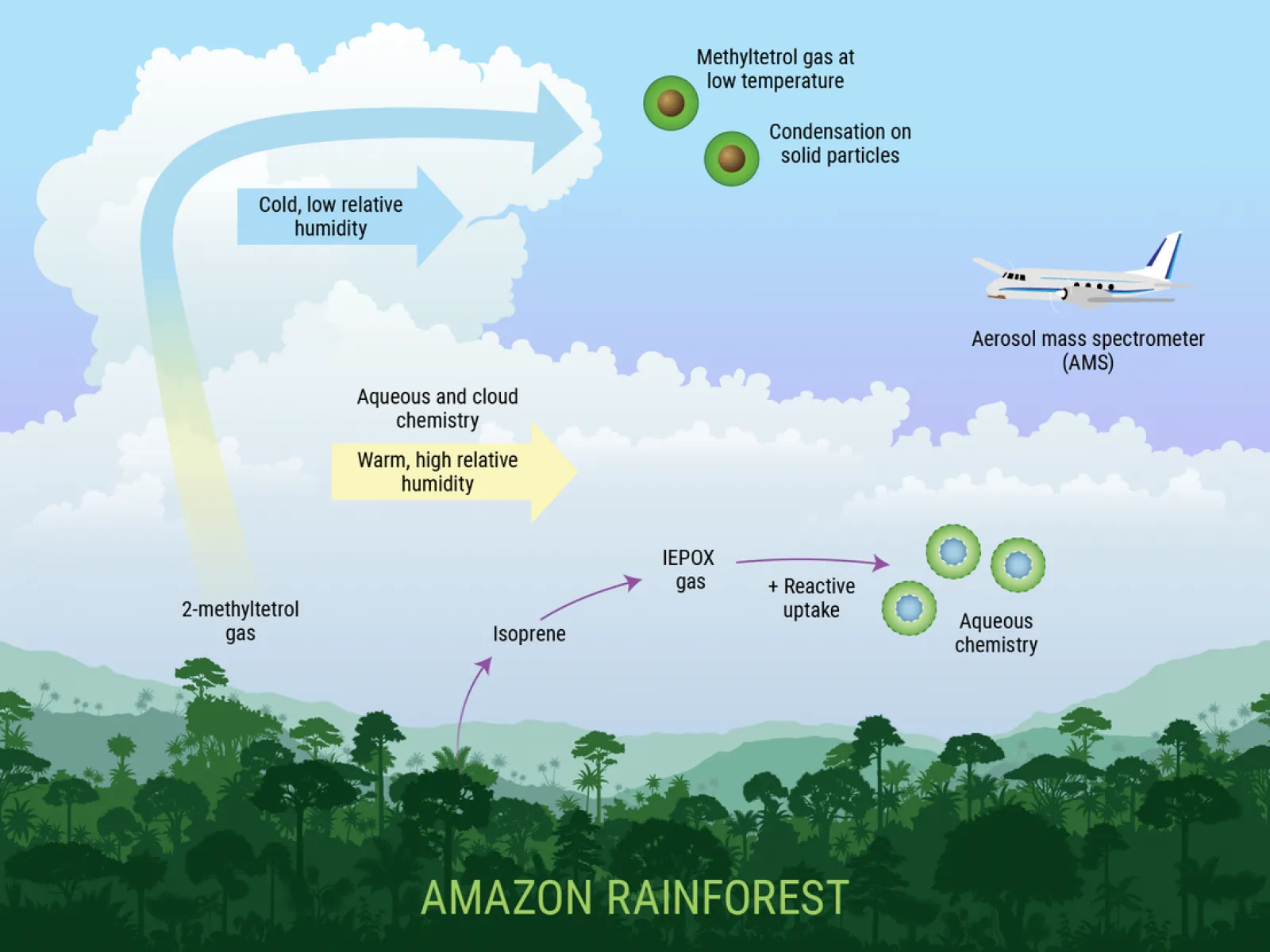According To A New Study By Scientists At The Pacific Northwest National Laboratory (PNNL), Gases Produced By Plant Leaves Create A Previously Unknown Atmospheric Phenomenon Over The Amazon Rainforest This Discovery Is Of Great Significance To Atmospheric Science And Climate Change Modeling.
Manish Shrivastava, A PNNL Geoscientist And Lead Investigator Of The Study, Said: "the Tropical Amazon Rainforest Constitutes The Lung Of The Earth. This Study Links The Natural Processes In The Forest With Aerosols, Clouds And The Radiation Balance Of The Earth, Which Has Not Been Recognized Before."
The Study Was Recently Published In ACS Earth And Space Chemistry A.
Filling The Missing Data Gap
When Studying Fine Particles In The Upper Atmosphere, Shrivastava And His Colleagues Observed A Huge Difference Between Their Results And Those Expected From Existing Atmospheric Models. Further Investigation Shows That The Current Atmospheric Model Lacks The Key Interaction Between Forest And Atmosphere, Which Restricts The Number Of Fine Particles In The Upper Atmosphere.
The Researchers Found A Previously Unrecognized Process Involving Semi-volatile Gases Produced By Plants In The Amazon Rainforest And Brought Into The Upper Atmosphere From Clouds. These Gases Are Natural Carbon Based Compounds And Can Easily Condense Into Fine Particles In The Upper Atmosphere. Shrivastava Pointed Out That This Method Is Particularly Efficient In Producing Fine Particles At High Altitude And Low Temperature. These Fine Particles Cool The Earth By Reducing The Amount Of Sunlight Reaching The Earth. They Also Produce Clouds That Affect Precipitation And Water Circulation.
"Without A Full Understanding Of The Semi Volatile Sources Of Organic Gases, We Simply Cannot Explain The Existence And Role Of Key Particulate Components At High Altitudes," Shrivastava Said
Key Discoveries In Atmospheric Processes
Shrivastava's Research Project, Funded By The Early Career Research Award Of The U.S. Department Of Energy (DOE), Involves Investigating The Formation Of Aerosol Particles Called Isoprene Epoxy Glycol Secondary Organic Aerosols (epox SOAs), Which Are Measured By Aircraft Flying At Different Altitudes.
Iepox SOAs Are The Basic Components Of Fine Particles Found At All Heights In The Troposphere, Which Refers To The Atmospheric Area Extending From The Earth's Surface To About 20 Kilometers Above The Tropical Region. However, The Atmospheric Model Does Not Fully Take Into Account These Particles And Their Impact On Clouds Over The Earth.
"Since The Model Does Not Predict The Observed Iepox-soa Load At An Altitude Of 10 To 14 Kilometers In The Amazon, We Have What I Think Is A Failure Of The Model Or A Lack Of Understanding Of The Measurement Results. I Can Explain The Surface, But I Can't Explain The Situation At High Altitude," Shrivastava Said
Shrivastava And His Team Searched Data Collected By The Grumman Gulfstream-159 (g-1), A Ministry Of Energy Flight Laboratory Operated By The Atmospheric Radiometry (ARM) Aviation Facility, Which Was Flown To An Altitude Of 5 Kilometers. The Team Also Compared Data Collected By A German Aircraft Called The High Altitude And Long Distance Research Aircraft (halo), Which Flew At An Altitude Of 14 Kilometers. Shrivastava Said That According To The Prediction Of The Model, The Load Of Their Iepox SOAs Should Be At Least One Order Of Magnitude Lower Than The Measured Results. Neither He Nor His Colleagues Outside PNNL Can Explain The Difference Between The Measurement Results And The Model Predictions.
Before The Team's Research, Scientists Believed That Iepox SOAs Were Mainly Formed By Heterogeneous Atmospheric Chemical Pathways. However, The Atmospheric Chemical Pathway Required To Produce Iepox SOAs Does Not Occur In The Upper Troposphere Because Of Its Extremely Low Temperature And Dry Conditions. At That Height, Particles And Clouds Freeze And Lack Liquid Water. Therefore, Researchers Cannot Use Existing Models To Explain Their Formation Observed At An Altitude Of 10 To 14 Kilometers.
In Order To Solve This Mystery, The Researchers Combined Special High-altitude Aircraft Measurement With Detailed Regional Model Simulation, And Then Simulated It Using The Supercomputing Resources Of PNNL's Environmental Molecular Science Laboratory. Their Research Reveals Undiscovered Parts Of Atmospheric Processes. A Semi Volatile Gas Called 2-methyltetraalcohol Is Transported By Cloud Updrafts To The Cold Upper Troposphere. The Gas Is Then Condensed Into Particles And Then Detected As Iepox SOAs By The Aircraft.
"This Is Certainly An Important Discovery Because It Helps Us Understand How These Fine Particles Form, So We Have A New Understanding Of How Natural Processes In Forests Cool The Earth And Contribute To Clouds And Precipitation. With Global Climate Change And Rapid Deforestation In Many Parts Of The Amazon, Humans Are Disrupting The Key Natural Processes That Produce Fine Particles In The Atmosphere And Regulate Global Warming," Shrivastava Said
Open The Door For Further Atmospheric Research
Shrivastava Said The Team's Findings Only Touched The Surface In Understanding The Newly Discovered Atmospheric Process And How It Affects The Formation Of Fine Particles In The Atmosphere. He Said The Newly Discovered Process From Plants Could Explain A Wide Range Of Atmospheric Particles Over Other Forest Areas Of The World.
"In The Grand Plan, This Is Just The Beginning Of What We Know And Will Open Up New Research Areas For Land Atmosphere Aerosol Cloud Interactions. Understanding How Forests Produce These Particles Can Help Us Understand How Deforestation And Changing Climate Will Affect Global Warming And The Water Cycle," Shrivastava Said.


